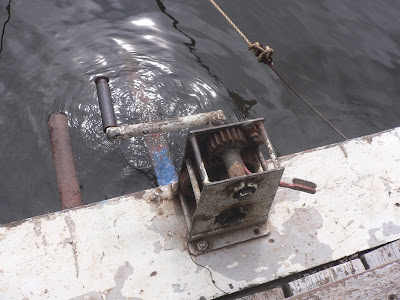We've mentioned transport in previous blogs, so we thought it was time to give you a bit more of a taste of how people get about in Cambodia. To start off with, everyone can ride a bike and, in the countryside, that's what most of them do. The great majority of the bikes are simple and ancient, just like the ones VSO issue (and many of which subsequently miraculously move on to Cambodian owners - between us we're now on bikes numbers 5 and 6 and no, we didn't forget to lock them up). However, the bikes only come in one size, which can cause one or two challenges as you can see below:

Once you've mastered the trick of getting on and off, the next thing to do is to see how much you can load onto a bike without breaking it. The chap below is far from achieving the maximum load: the best we have seen so far is a convoy of about 6 bikes all carrying bundles of logs all about 8 feet long, put sideways on the back rack to get them to stick out about 4 feet on each side. That's the same width as a London bus. Perry's own personal best is 3 chairs and 2 stool tables, right along the busiest road in Phnom Penh.

For passenger transport, the realistic limit for a bicycle seems to be 3 people; at least, we've never seen any more than that on one yet. For a more comfortable option, however, you need a cyclo.

Cyclos are only found in Phnom Penh and date back to the 1930s (both the concept and the actual cyclos themselves, plus quite a few of the drivers). Designed to carry a rider and one passenger, they will quite happily accommodate an entire family plus bags or, in one case that we saw, what appeared to be a full set of plumbing for a new appartment building.
Of course, to move over longer distances, you need a moto - especially if you want to take your bike with you.

There appears to be no actual limit to what can be carried on a moto - people, goods, livestock, you name it. We've seen them with dead pigs on the back seat, completely covered with live ducks or bananas so that you can only see the body of the driver and the very bottoms of the tyres and, our personal favourite, one carrying a complete set of bedroom furniture. What's so special about that? A full-scale king size bed stood upright on the back seat and two chests of drawers tied to the sides. Plus a couple of bedroom chairs.


As you can see above, goods and passengers are not mutually exclusive. In the background is an older form of transport, but one still used everywhere in the countryside: a pony cart. Animals are used a great deal for pulling carts; ponies, cows and water buffalos are the most common. The picture below was downloaded from AP; we'll replace it with one of our own when... well, basically, when we get our act together and have the (new) camera on us (see the next blog for the sad story of the poor little camera - this time, it was death by water).

As the engraving below shows, they've been around without much change for centuries.

As the engraving below shows, they've been around without much change for centuries.

For bigger loads, you have to find a truck. Or make one. We're particularly taken with the deluxe accommodation for the driver and his mate.

For passengers, there are a number of options. Buses, usually very second hand, are the high end of the market. For most Cambodians, the normal way to get from town to town is by minibus or pick-up truck. Both are available in double-deck versions.

And, just like London double-deckers, standing passengers are allowed.

And now to consider the roads. Trust me, it's fun!

And when the roads get too wet even for Cambodian traffic, you can always find a ferry to take you to the next mudbath.

Maintenance of all these vehicles is to the very highest standards. Yes, that is a toothbrush being used to lock the winch on this boat.

Back on land, elephants aren't really used for transport in Cambodia any more, although we have seen one trundling down the side of the road in the Cardamom mountains bearing its rider and all his worldly chattels. Overall, it's probably just as well, as adding Jumbo below (pictured carrying tourists at Angkor Wat) to the traffic mix in Phnom Penh might just be the final straw. We would certainly give way on our bikes but we suspect that there are quite a few local drivers who just wouldn't notice something so small and discrete in their way.

More soon. In the meantime, please don't forget the need to keep supporting VSO through our Justgiving page at www.justgiving.com/jagoteers. They need the money to replace all the bikes that keep getting nicked.



